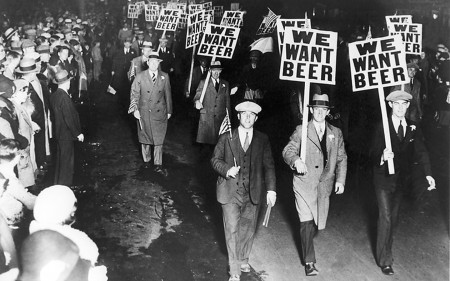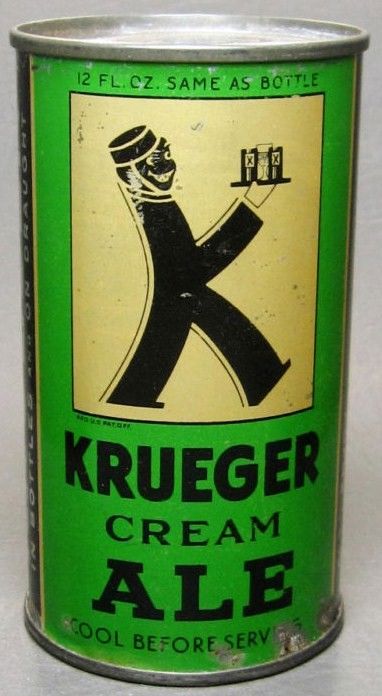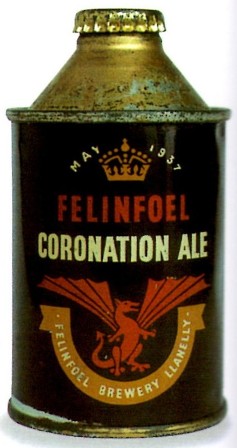EXPLOSIVE EXPLOITS OF THE TIN MEN...
The more pressing matters of tin technology...
Perception is a strange thing. It is one of those unquantifiable factors that has few basis of logic, and what may be considered undesirable by one, appears to attach a premium to others.
The debate over canned and bottled beers is a case in point. Whilst there are those who see cans as the poor (or unacceptable) relation of bottles in selling beer, is this really the case today given modern technological advances?
Both have their merits as means of presenting and conveying the finished article to the drinking public, but one in particular ( in Western European culture) suffers from an image problem - cans.
This is because it still carries with it the baggage associated with its earliest incarnations, and one particular demon that has plagued it ever since!
So just how did can's find their controversial way into brewing history?
The end of Prohibition in the United States in 1933 heralded the start of a new era, and with beer production reaching new heights, can manufacturers were keen to be part of this escalating boom.
Tin however was an expensive commodity at the time compared to glass, allied to the fact that technology had simply not been advanced enough to deal with the idiosyncrasy beer possessed.
One company however, The American Can Company (or Can Co.) felt confident it found the solution.
Although canning of food products had dated back to the earliest part of the 19th Century, beer had posed a trickier proposition with its high levels of Co2 offering something more akin to a potential explosive device!
The solution to this was to employ a vinyl lining which would prevent the seam of the can being forced apart, making the container a less appealing option to the US military!
Canned beer was first introduced to the drinking public in January 1935 in America, with Kreuger's Finest Beer and Cream Ale from Virginia being the first brands to move into this new arena.
With this new technology in place can's popularity soon took off in the USA, with convenience for retailers in terms of stack ability, and weight over bottles for consumers, being their greatest attribute up to this point.

With Prohibition in America - the message was clear!


In Europe the first brewery to can its product was the Felinfoel Brewery of Llanelli in Wales, which was done more out of expediency to promote the flagging fortunes of the tin plate mining industry in South Wales at the time, rather than a general desire to embrace this new form of packaging.
Its introduction however had followed only eleven months after the successful launch of Kreuger's in the United States, in December 1935.
Unlike the early US flat topped cylindrical design, which made sense in terms of storage and space, the Felinfoel can, with its cone top, lacked aesthetic appeal more closely resembling a tin of Brasso than beer!
The design did however hold one advantage over the cylindrical tin, which required a separately designed opener to pierce the lid, the cone top simply unscrewed.
Made by The Metal Box Company the cone top went on to be adopted by a number of British breweries thereafter.
A CONTROVERSIAL ELEMENT...
The one aspect of canned beer history that has remained the most controversial in the eye of the drinker, has been the most important of all - the flavour itself.
Despite early claims on both sides of the Atlantic as to the 'superiority' can's offered in terms of flavour, it soon became apparent to the drinking public that a 'taint' (variously described as 'tinny' or 'metallic' ) was damaging its credibility, and a suspicion arose amongst the public that brewers were offering 'inferior' brews by the can, something many vehemently denied.
Nevertheless can technology pressed on, and the neutrality of flavour the brewers were seeking was finally achieved with the introduction of aluminium
ENVIRONMENTAL IMPACTS...A NEW AGENDA
One other aspect which was never even a consideration for the early can pioneers, but a hot topic today, is the recyclable qualities it possesses.
For the bottle19th Century attitudes toward glass production seemed to follow two paths. One, which is still practised in a number of countries worldwide, and the most cost effective, was to return them to the brewery (via a deposit) to be washed and re-sterilised. The other, in Victorian times at least, was to simply bury the bottles in pits - much to the delight of antique bottle collectors today!
At first glance aluminium too also looks like a ready candidate in the recyclable stakes (compact, easy to crush, with a good tonnage to volume ratio) with no shortage of availability being the third most common element in the world.
The problem however ironically exists in its initial manufacture, not at the end of its life, which requires a great deal of energy, which in turn requires oil - a fast disappearing global resource.
A NEW PERCEPTION...
Interestingly then whilst can's have always been subject to a mixed response in terms of beer in Western Europe, with the opening up of Eastern Europe, the perception has been very different.
With a history almost entirely based on the bottle deposit system the can is seen as something new and aspirational, a 'premium' packaging evoking a more 'modern' affluent image. So much so that canned beers in Eastern Europe, unlike the West, sells at a higher price than their bottled counterparts!
Their perceived value then is a complete reversal to the established view of canned beer in West, based less on the contents within, and more as a symbol of social aspiration and mobility.
Perhaps it goes to show that there really is truth in the saying "beauty is in the eye of the beholder" and long may the debate over the virtues of 'Bottles versus Can's' continue to bubble along...
Who the winner will be, maybe mother nature will have the final word.
---------------------------------------------------------------------------------------------------------------
TO RETURN TO ARCHIVE CLICK ON ARROW TOP OF PAGE